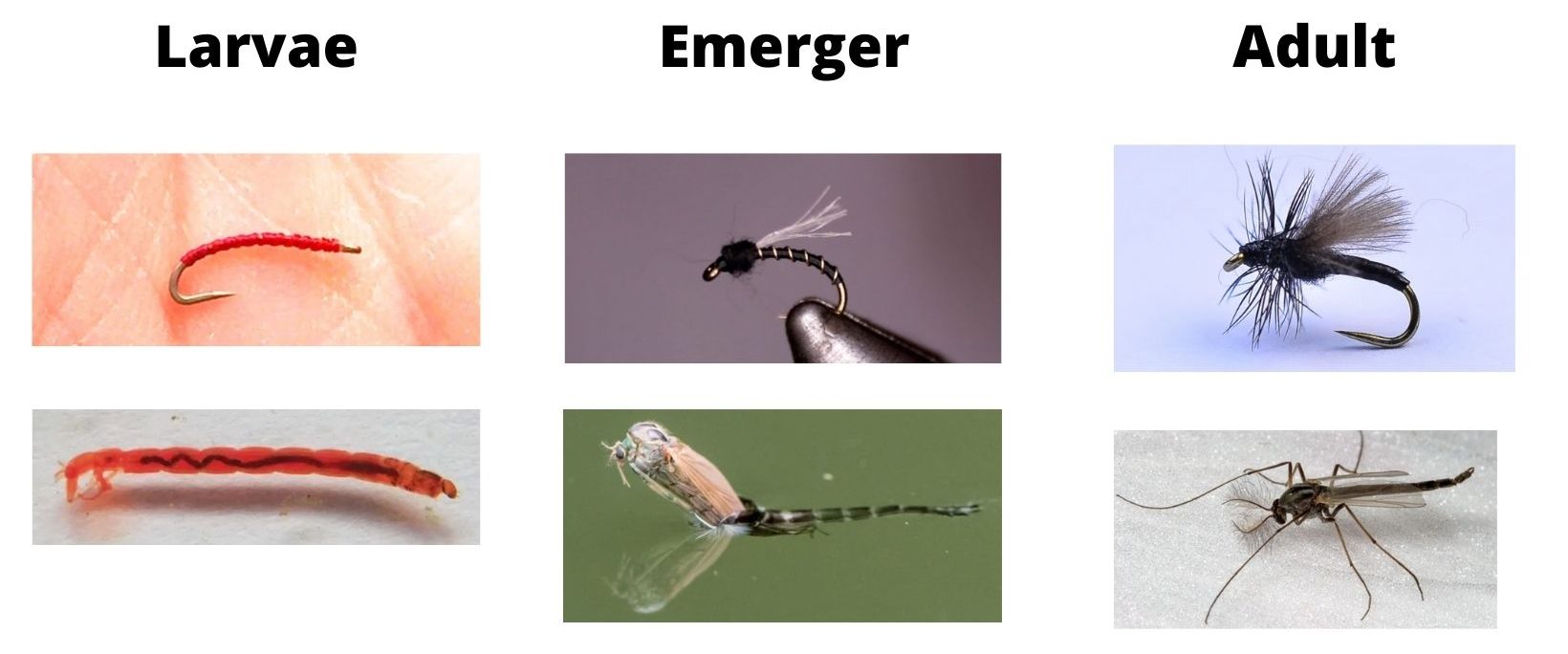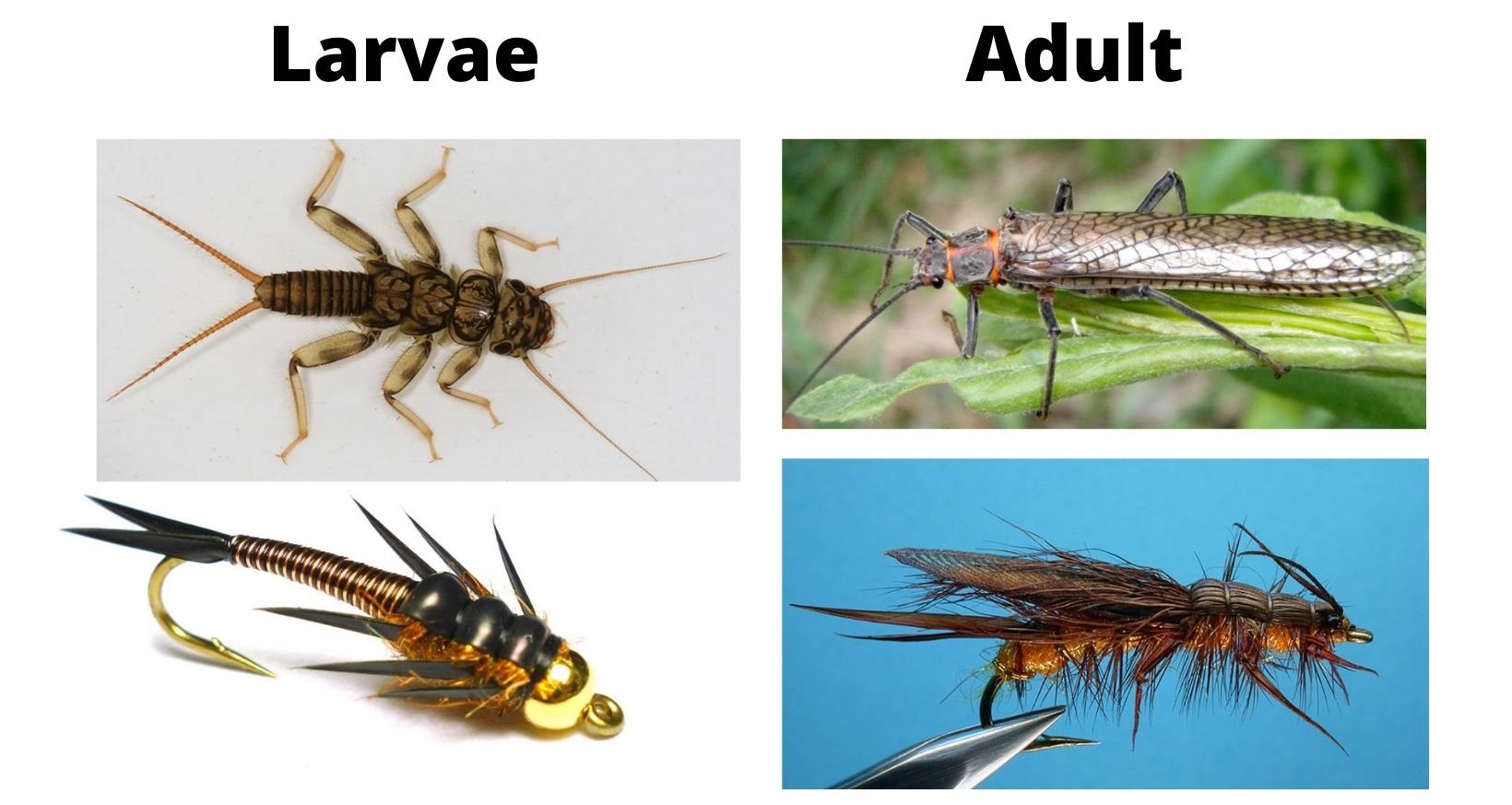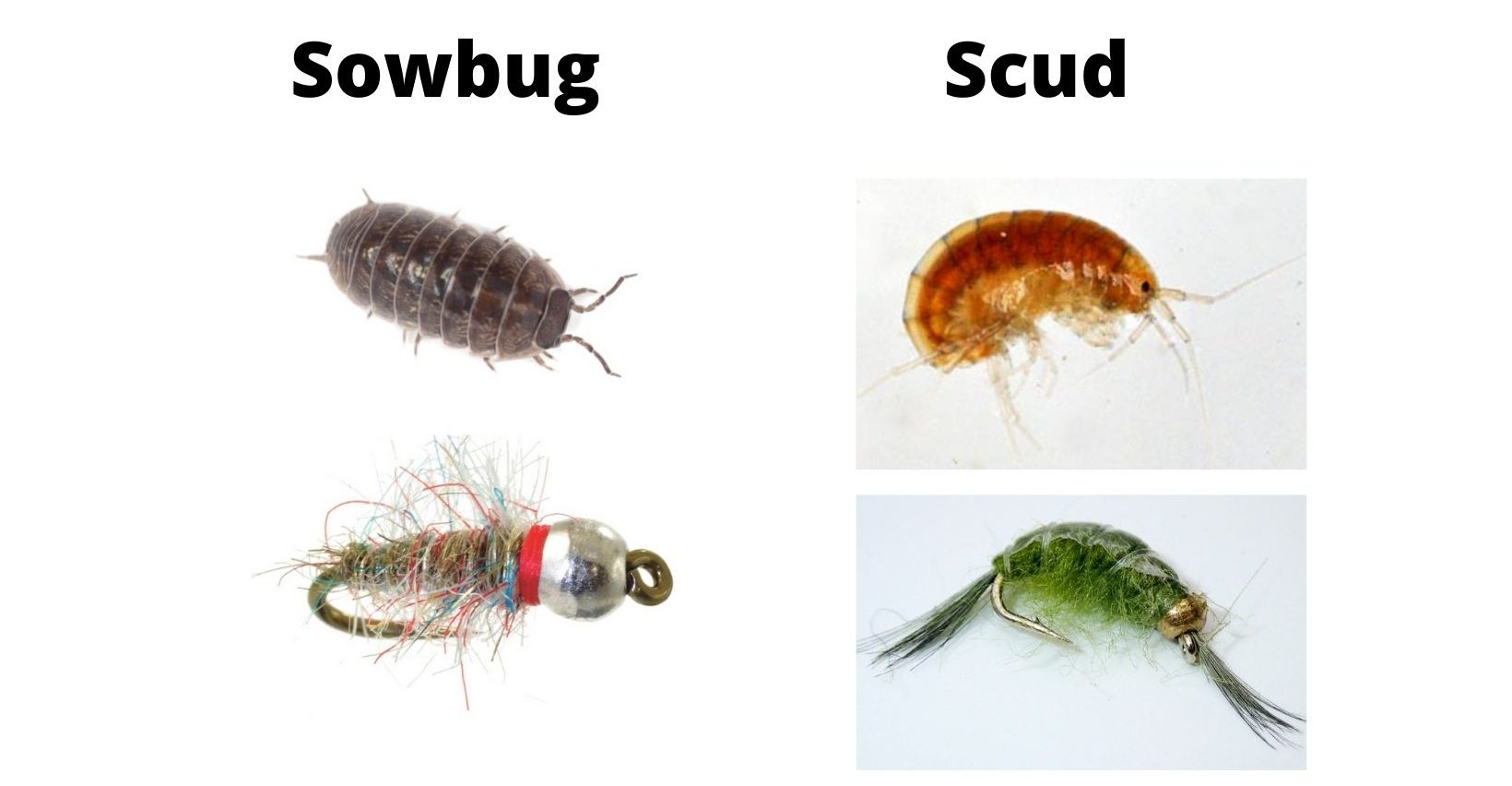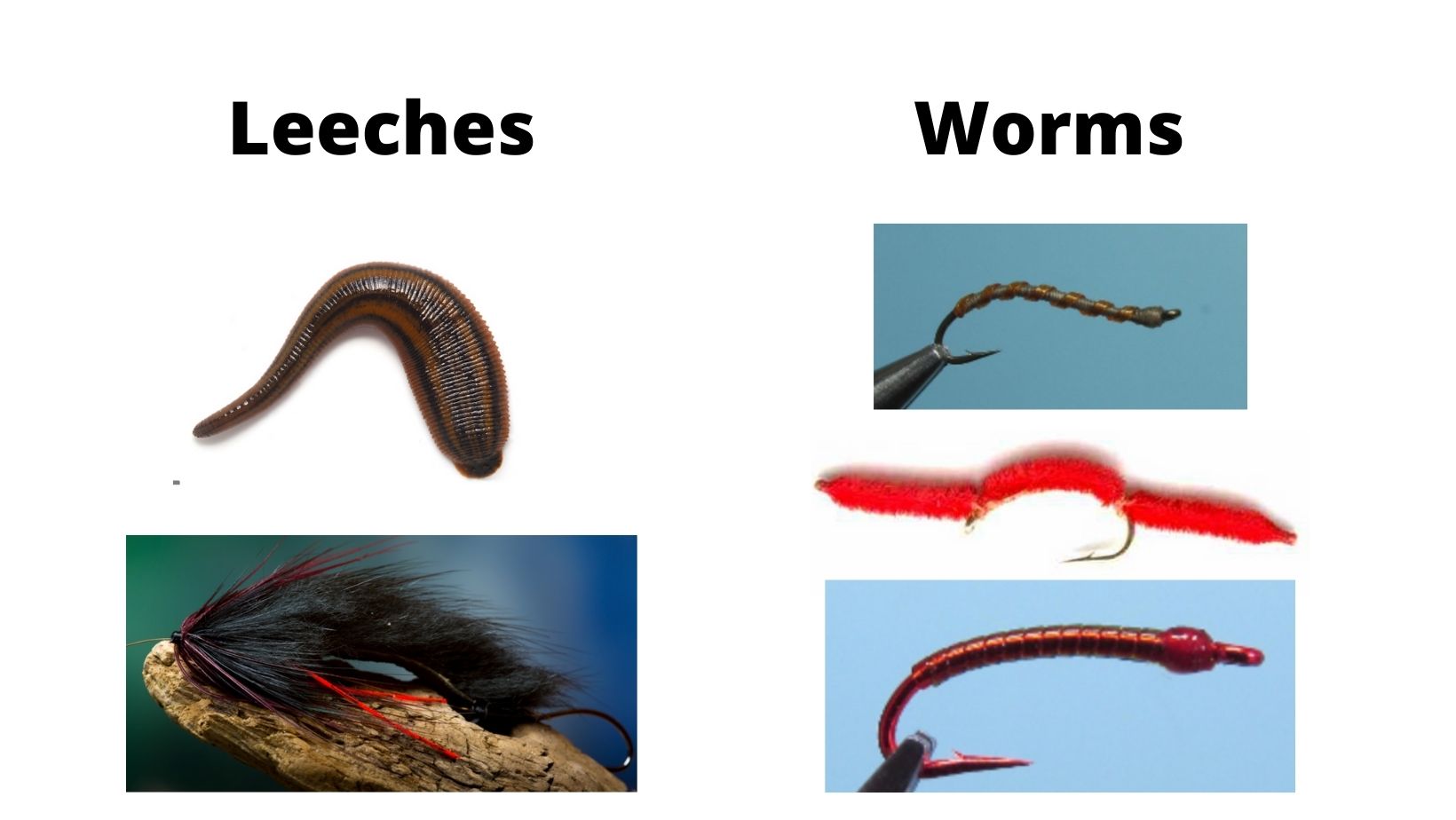Part of the appeal of fly fishing is the vast variety of flies. Each fly pattern looks unique, and many are beautiful, tiny pieces of art. But there’s a reason for all of this variety: each type of fly has a purpose, and even minor differences can make a huge difference on the water. In this guide, we’ll cover all the different ways that flies can be categorized, what situation each type is used for, and what kind of fish they may attract.
Quick Navigation:
Common Categories Of Flies | Fly Fishing Entomology | Wet Flies By Category | Other Flies | How To Choose | Where To Buy | Must Have Flies
Major Categories of Flies
To think about the types of flies, it helps to have some categories in mind. This way, you’ll have an idea about how different types of flies are related to each other, and how they’re different. The first big division is wet flies versus dry flies (see examples for each here). While some types of fly are interchangeable (for example, you can use flies from different entomological (aka, insect) categories in similar situations), wet flies can’t be used to substitute for dry flies and vice versa. A situation that calls for a wet fly will rarely be met successfully by a dry fly.
You can get more detailed information about wet and dry flies in our guide here, including photographic examples, but here’s the vital information that you absolutely need to know.
Wet Flies
Wet flies are designed to be presented to fish below the water’s surface. These flies often include a weighted component called the bead head to allow the fly to sink faster; however, in some shallow, slow waters you might want lighter, beadless wet flies to not scare the fish or drag the bottom.
Wet flies tend to look like juvenile insects, fish eggs, crawfish, leeches, worms, small fish, and other small creatures that look like a meal to a hungry fish. Some wet flies are designed to skim as close to the bottom as possible, while others are meant to sit just below the surface of the water. Streamers, a type of wet fly, are used to mimic baitfish, leeches, and other aquatic organisms that have swimming capabilities. Streamers can be fished like nymphs, or fished with movement. We explain each of the types of wet flies in further detail below.
View Orvis Wet Fly Examples | View On Amazon
Dry Flies
Dry flies are designed to sit atop the surface of the water and made to mimic insects that are emerging to fly away or insects that have landed on the surface of the water. In many cases, dry flies may be designed to resemble the adult version of wet flies, which may be the larval or nymph stage of semi-aquatic insects) other dry flies are made to seem like injured or trapped terrestrial insects (grasshoppers, beetles, etc). Lightweight enough to not break the surface tension of the water, dry flies may create small ripples to attract fish, but otherwise tend to disturb the water less than wet flies.
Fly Fishing Entomology (the study of insects)
Another way to think about flies is by the insect they’re designed to mimic. In our guide to fly fishing entomology, we go over the different types of fly patterns and the bugs they represent in great detail. The main idea to take away here is that fish are eating different kinds of insects at different times of the year, and knowing what fly patterns resemble what insect life will help you know what the fish are taking.
Midges
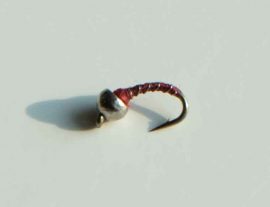
Zebra Midge
Midges are tiny insects that look like and swarm like mosquitoes. Midges are exceptionally small, so flies tied in a midge pattern are always on smaller hooks. Midges are available year-round on the water and are a stable food source for fish. Midges can be dry or wet flies; flies that look like adult midges are dry flies, and flies that look like midge larvae or emergers are wet flies.
The following fly patterns are midge patterns: Pale Olive Midge Larva (size 16-20), CDC Transitional Midge (size 18-20), and Griffin’s Gnat (size 16-22), Zebra Midge.
Mayflies
Mayflies are insects with triangular, upright wings. They aren’t just found in May, although that is where they emerge in many places. Flies that resemble mayflies can be both wet flies and dry flies. Flies that mimic larvae and emergers are wet flies, while flies that look like adults or “spinners” are dry flies. Spinner mayflies are clear-winged, active adults at the end of their life cycle, and their high activity level can be very appealing for fish.
The following fly patterns are mayfly flies: Hare’s Ear (size 10-22), Parachute Flies (size 10-22), Rusty Spinners (size 16-20), and Callibaetis spinners (size 12-18).
Caddis
The caddis is another abundant food source for trout and other fish. They are eaten at every stage of the life cycle. Caddis nymphs live underwater, and flies that mimic these nymphs and emergers will be wet flies. There are two forms of the caddis larva: cased and uncased. Uncased larvae look like other grubs, but cased larvae create a hard, durable shell with the silk they produce and bits of debris like gravel, sand, twigs, and pieces of plants. These cases cannot protect them from hungry trout, and so you will see fly patterns based on both types of caddis nymph. Adult caddisflies are dry flies. The larvae are wet flies.
The following fly patterns are caddisflies: Elk Hair Caddis (size 12-16), Deep Sparkle Pupa (size 12-16), and Shark’s Caddis Larva (size 12-16)
Stonefly
Stonefly patterns can be used year-round due to their unusual emerging time: unlike most insects, which emerge in late spring and early summer, stoneflies emerge as adults in winter and early spring. Stoneflies are typically larger than other insects that fish prey on and often do well in fast water with rocky bottoms. Stoneflies only have two life stages; nymphs don’t use gas propulsion to get to the surface as they mature, so there aren’t emerger fly patterns for this species. Flies based on stonefly larvae are wet flies; the adults are dry flies.
The following fly patterns are stonefly flies: Little Black Stonefly (size 12-18), Knuckle Dragger (size 8-10), Chubby Chernobyl (size 6-16)
Terrestrials
Terrestrials are the largest and least specific category of insect, and fly fishers don’t have to worry about knowing their emergence patterns or where they hatch. This is because terrestrials all have an incidental presence– they don’t live in the water, but rather they end up there because they were blown into it or some other accident occurred. These flies usually mimic grasshoppers, beetles, ants, spiders, moths, and other arthropods that might incidentally land in the water. These come in many patterns and are particularly good for windy days or along steep embankments where a bug could get swept into the water. Terrestrials are almost always dry flies.
The following fly patterns are terrestrial patterns: Carl’s Cicada, Power Ant, Charlie Boy Hopper, and Black Beetle. These can be tied in a variety of sizes, usually anywhere between 10 and 20.
Scuds and Sowbugs
Scuds and sowbugs are small aquatic crustaceans. Scuds resemble shrimp, and sowbugs look a lot like other isopods (like pill bugs). Flies that mimic them all mimic the adult stages, as the larvae look just like miniature adults. Scud and sowbug flies are always wet flies since these animals spend their entire life cycle in the water.
The following are scud patterns: Garbage Scud, Olive Scud Nymph, and Ray Charles Scud. The following are sowbug patterns: Firebead Ray Charles Soft Hackle, Killer Bug, and Pete’s Carpet Bug. Scuds and sowbugs are fairly small, so most of these flies should be tied in the 14-22 range.
Annelids
Annelids, or worms, are another type of invertebrate eaten by fish. During rainstorms, earthworms and other annelids get washed into waterways and are devoured by hungry trout and other fish. Additionally, annelids like leeches are present at all times in many waterways, making this an effective fly pattern throughout the seasons. While annelid fly patterns can be fished year-round, they are especially effective in spring and after rainstorms. They can also be very effective in cold waters or during winter fishing. Annelids in general only have one recognizable life stage; like scuds and sowbugs, the juveniles look just like small adults. All annelid fly patterns are wet flies.
The following are annelid patterns: San Juan Worm, Squirmy Wormy, and Chamois Worm. Worms are appropriately sized in the 10-14 range. You’ll often find San Juan worms tied larger, and you may find other annelid patterns as small as size 22.
Damselflies, Dragonflies, and Water Boatmen
The last group of fly patterns based on insects are the damselflies, dragonflies, and water boatmen. Though these insects are not closely related, they are grouped because they don’t have mass hatch and die-off cycles like the various flies discussed above. The larval stages of all of these are wet flies. While adult dragonflies and damselflies are dry flies, fly patterns based on water boatmen can be dry or wet flies.
The following patterns are damselfly, dragonfly, and water boatman patterns: Whitlock’s Gorilla Damsel/Dragon (size 2-8), Red Shoulder Dragonfly Nymph (size 6-10), and Tim’s Water Boatman (size 12-16).
Wet Flies By Category
While all wet flies are presented under the surface of the water, different types of wet fly are presented at different locations in the water column. Unlike dry flies, which are all presented on top of the water, there are different categories of wet fly. These are based on different stages of an insect’s life. Here, we’ll go over the different types of wet fly and where they are presented in the water.
Nymphs
In fly fishing, a nymph is the larval form of an insect. (In entomology, there are some differences between nymphs and larvae, based on how closely they resemble the adult stages– but when it comes to fly fishing, all larvae are fished as nymphs.) Nymphs can be presented high or low in the water column, and are often fished towards the bottom of the water.
Emergers
Emergers are the final larval stage of an insect. Emergers often form a cocoon or shell that contains a shiny gas bubble. This bubble is used to propel them to the top of the water, where they can emerge from their shell, let their wings dry, and fly away. Emergers are presented at the top or middle of the water column.
Streamers
Streamers are wet flies that are built to resemble baitfish. These flies are larger than many other types of freshwater fly, and are useful for any type of predatory fish. Big trout and salmon, as well as catfish, bass, and many others will strike at streamers. Streamers are presented in the bottom, middle (most common), and top of the water column and many say they do best in deep, murky water.
Other Fly Types
While most flies fall into the “wet fly” or “dry fly” category, there are other types of flies you may encounter as well. These flies are situationally useful; while they’re not for general use in all types of water, there are times when nothing else will do.
Poppers
Poppers are wet flies that are presented at the top of the water. These are similar to streamers in that they mimic baitfish sometimes, but specifically they mimic wounded baitfish. Some poppers also mimic other animals, like frogs, mice, and other small vertebrates that might get swept into the water. Even though these are wet flies, they are fished right at the top and are “popped” by the angler to mimic the movements of a wounded or swimming animal. These are often irresistible to predatory fish and are particularly popular with people fishing for bass.
Saltwater Flies
Saltwater flies are typically large flies based on streamer or popper patterns. The further you get from the shore, the fewer insects are available, so saltwater flies often resemble crabs and other small crustaceans, baitfish, and shrimp. Saltwater gamefish are often very large (when compared to freshwater flies), so these flies tend to be on the largest end of the fly size spectrum.
Which Fly Type To Use?
The first way to choose your fly type is by matching it to the water you are fishing, and the fish you are targeting. But what if you don’t have a particular fish in mind, or you’re new to the sport and just figuring out what type of fishing you like to do? First off, we recommend going to a fly shop near where you plan on fishing, this is the best place to start, and we will explain this further in our “where to buy” section.
Beginner and novice fly fishermen often prefer wet flies for their ease of use, since wet flies are used to catch fish that are feeding below the surface. Even if fish aren’t feeding at the surface, they’re usually feeding below the surface. Wet flies also let you fish in deeper waters, which is often easier than fishing at the surface. This is because fish are often (though not always!) less likely to be spooked by false movements or splashes because they tend to feel safer in deeper waters.
Wet flies are also more forgiving than dry flies. Learning to cast with a fly rod is a real challenge! Even experienced anglers sometimes find that wet flies allow more leeway for mistakes and that using them can give you room for error without scaring off all the fish.
For beginner fly fishers, fishing with dry flies can be more challenging than fishing with wet flies. You have to learn the proper casting and presentation techniques, and that can be tricky. When fishing with dry flies, there is often very little margin for error, since you’ll be targeting fish willing to feed at the surface of the water. With this being said, certain situations can still be fantastic for beginner fly fishermen to utilize dry flies. You will also need to know how to mend properly; while you can often get away using the high stick technique with wet flies, dry flies often require more precise line control for a natural presentation.
Even though it’s more technically challenging, dry fly fishing is very exciting. Anglers who get into it often do so because they love the play of the fish at the surface of the water; they get to see every part of the action from the time the fish strikes to the time you pull the hook out of its lip.
Where To Buy Flies
We absolutely recommend buying flies from your local fly shop, or the fly shop where you plan on fishing. This helps support local businesses, but will also help you catch more fish. Local fly shops are constantly on the water and testing flies, so they know what flies are currently working well vs what flies aren’t working well for the fish in the area. We do know that you may need the convenience of purchasing flies online, so here are some locations to consider (though you’ll find dozens of options):
Trouts Fly Fishing
Orvis
Trident Fly Fishing
Rio Products
These are a few of the highest quality online options available. Many local fly shops may also offer purchasing online. We recommend avoiding. You will find cheaper options, but keep in mind that these are reputable companies that provide high quality products. If you happen to have issues with your orders from these organizations, they will take care of you most likely. Cheaper options online can often have lower quality.
The Four Best Fly Patterns For Beginners To Learn To Tie
If you’re new to fly fishing, one skill you may want to learn is how to tie your own flies. While you can certainly buy flies, tying your own flies gives you a chance to get familiar with the entomology of your local waters. Tying flies is a way to participate in your local fishing community, even during the winter months when fishing may not be an option. Through tying, you can get a chance to find out what the local fly shop guides know about what patterns and colors work best in each area. You also get the chance to get creative and learn new patterns that might not be found in the local fly shop.
But getting into fly tying can seem a little overwhelming. There are thousands of different fly patterns out there, and some of them can be really complicated. However, there are a few old favorites that every beginner should learn. These standards are used by top anglers as well as total newbies, and they’ll form the basis of your fly-tying experience. We’ve chosen four of the best, most versatile patterns that every fly fisher will want to know how to make.
1. The Wooly Bugger
The wooly bugger is a versatile fly that can be used in many different fishing situations. It is also a good fly for beginners to learn to tie because it uses fundamental skills that are easy to learn and necessary to know for tying more difficult flies. The Wooly Bugger is a suggestive pattern, rather than an imitative one. This means that you can get creative with the colors you choose because it looks like many food items but does not imitate anything specific.
2. Elk Hair Caddis
The Elk Hair Caddis is a staple dry fly. It skates nicely over the water, floats high, and is durable– and it’s very good at catching fish. While this fly can be tricky to learn how to tie at first due to the need to angle the wing, knowing how to tie an Elk Hair Caddis is another great fundamental skill to develop.
3. The Hare’s Ear Nymph
The Hare’s Ear is a classic fly pattern learned by beginners for decades. It’s one of the fly patterns that every fly tier should know, because it’s so versatile. The Hare’s Ear has the fundamental components of most basic nymphs—a tail, spiral-wrapped rib, abdomen, wingcase, and thorax. But it can easily be adapted to mimic a wide range of insects. If you make it longer, you have a Callibaetis nymph. If you make it broader, you have a stonefly nymph. The Hare’s Ear is a useful fly for many seasons and water conditions, and if you’re going to learn how to tie a wet fly, this one just might be the best one to learn.
4. The Zebra Midge
The Zebra Midge is a very simple fly pattern, but don’t let its simplicity fool you: this fly pattern catches tons of fish! With a large, shiny bead head and some synthetic or natural dubbing, the Zebra Midge is easy to tie and can be customized in a variety of colors based on what’s popular with your local trout. Bonus, this fishes well year round, where many flies don’t get results during specific seasons.
What Is The Best Fly?
The best fly is the one that catches fish, and you should always have several flies with you when you go fishing. Ultimately, the fly that is best to use depends on your local fishing conditions. You can never really know what the fish are going to strike until you’re out on the water, so it pays to know everything you can about the different types of flies, and be willing and prepared to experiment while you are on the water!
Max DesMarais is the founder of hikingandfishing.com. He has a passion for the outdoors and making outdoor education and adventure more accessible. Max is a published author for various outdoor adventure, travel, and marketing websites. He is an experienced hiker, backpacker, fly fisherman, trail runner, and spends his free time in the outdoors. These adventures allow him to test gear, learn new skills, and experience new places so that he can educate others. Max grew up hiking all around New Hampshire and New England. He became obsessed with the New Hampshire mountains, and the NH 48, where he guided hikes and trail runs in the White Mountains. Since moving out west, Max has continued his frequent adventures in the mountains, always testing gear, learning skills, gaining experience, and building his endurance for outdoor sports. You can read more about his experience here: hikingandfishing/about
-
Beauty
-
Parking
-
Trail Conditions

